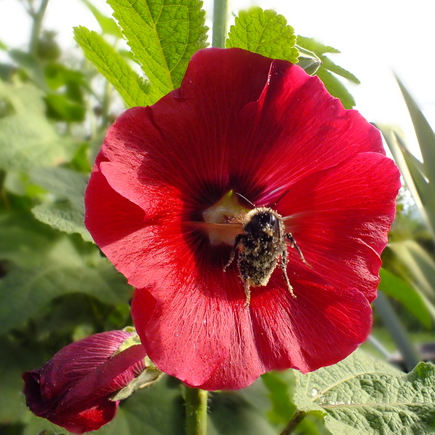Alcea rosea, commonly known as hollyhock, is a popular flowering plant that has been cultivated in gardens for centuries. It is native to southwestern and central Asia but is now grown in various regions around the world for its ornamental and medicinal qualities. Here are some of the uses and qualities of Alcea rosea plants:
- Ornamental Purposes: Hollyhocks are primarily grown for their attractive, tall, and stately flower spikes, which come in a wide range of colours, including shades of white, pink, purple, red, yellow, and even black. These showy flowers make hollyhocks a beautiful addition to cottage gardens, borders, and mixed perennial beds.
- Attract Pollinators: The flowers of Alcea rosea are rich in nectar and attract pollinators, such as bees, butterflies, and hummingbirds. By planting hollyhocks in your garden, you can help support local pollinator populations and promote biodiversity.
- Cut Flowers: Hollyhock flowers can be cut and used as cut flowers in floral arrangements, adding a touch of elegance and colour to bouquets and vases.
- Traditional Medicine: Some traditional medicinal uses of Alcea rosea involve using various parts of the plant for therapeutic purposes. For instance, the roots were used in herbal remedies to treat respiratory ailments, digestive issues, and inflammation.
- Emollient Properties: Hollyhock contains mucilage, a sticky substance found in certain plants that has emollient properties. The mucilage can be extracted from the plant and used topically to soothe and moisturize the skin, providing relief for minor skin irritations, burns, and wounds.
- Dyeing: The flowers of hollyhock can be used to create natural dyes. Different flower colours yield various shades, and these dyes can be used for colouring fabrics, yarns, and other materials.
- Historical Uses: In historical contexts, hollyhocks have been used for decorative and symbolic purposes. They were often planted around houses and gardens for protection against evil spirits, and their tall stature made them useful as windbreaks.
Qualities of Alcea rosea plants:
- Biennial or Short-Lived Perennial: Hollyhocks are generally biennial, meaning they complete their life cycle in two years. In the first year, they grow vegetatively as a rosette of leaves, and in the second year, they produce flowering stems. Some varieties may behave as short-lived perennials, coming back for a few years before eventually declining.
- Tall Growth: Hollyhocks can grow quite tall, ranging from 4 to 9 feet (1.2 to 2.7 meters) in height, depending on the variety and growing conditions.
- Hardy and Easy to Grow: Alcea rosea plants are relatively easy to grow, and they are considered frost hardy. They prefer full sun and well-draining soil.
- Self-Seeding: After flowering, hollyhock plants produce seed pods that can self-seed in the garden, leading to new plants in the following years.
- Resilience: Hollyhocks are generally resistant to pests and diseases, making them a low-maintenance addition to the garden.
Overall, Alcea rosea (hollyhock) is a versatile and attractive plant with a long history of cultivation for both ornamental and practical purposes.
